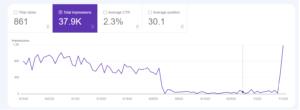As most of you probably heard, Google core update that rolled out around May 22 was one of the largest ones ever, affecting a big range of sites of different sizes and in different niches. Every single SEO related forum or a facebook group had someone asking for help to recover.
- Improve your contact info for better “EAT”
- Remove commercial intent pages
- Remove affiliate content
- Focus on internal linking
- And the usual suggestions like improve your content (without going into detail)
What may have been the problem
I took a look at one affiliate site that went down around that time. It was featuring a broad range of physical products in a couple of different niches. Most pages were well optimized and very relevant for the products featured (I don’t like to use the word quality). But the site didn’t only lose the rankings, it almost completely disappeared from the SERPS. Instead Google ranked pages that would casually mention the product name on the page, maybe once. This gave me a clue that Google stopped trusting the site if it refused to list pages that were obviously relevant for the products.
I suspected that the over-optimization was the problem, and started analyzing the site in question and its competition. I mostly used Screaming Frog, my own onpage analysis tool and (of course) manually observing all the pages.
What was observed to be the problem
It didn’t take long to figure that the site was overoptimized for its main keywords. Almost every page was overoptimized. It had the word in all the “right” places: url, title, h1, multiple h2, h3, strong, em, alt and anchor text from other internal pages pointing to a page. While this may not be a problem for every site (Amazon.com could get away with it, but most sites wont), this site didn’t have external signals to justify the overuse of onpage optimization, and Google stopped trusting it.
And it does make sense. If you are Google, you know that everyone is trying to SEO every site with the usual recipe. But Google won’t automatically trust them if they don’t have other signals.
How we recovered the rankings
We could have started acquiring links to try to get more credibility, but this would take too long and would be too expensive to justify the potential earnings of a relatively small site.
Quicker solution was to change onpage, that could be done within the CMS templates. There was no need for most H4 tags, so they were changed tags, and then changed their appearance in CSS so that the page still ends up looking the same.
H2 and H3 were stuffed with main keywords, so they needed the most fixing. We removed most occurrences of the main keyword and replaced it with entities that made sense in the context of product pages. Even added generic heading tags as most competitors had them and this watered down headings without modifying intent of the page. We kept the main keyword in paragraphs, tables and lists in appropriate amounts.
I changed the internal anchors with more variations of the full product name. For example, instead of every anchor being the full product name, it would be 3 or 4 words from the product name. This diversified the anchors and made them seem more natural. I did it by associating urls with their full product name in a DB, and then parsing the WordPress export xml and modifying them with only parts of the name (using php).

